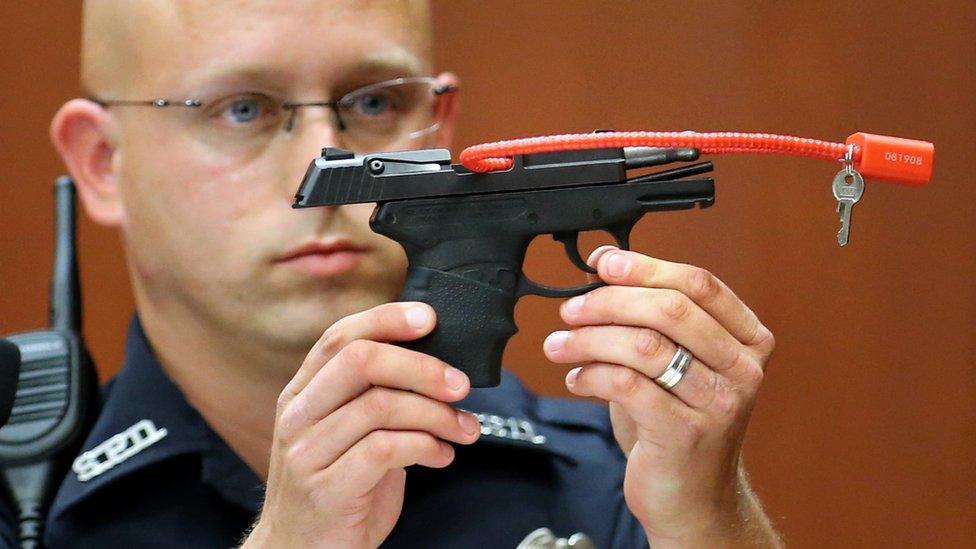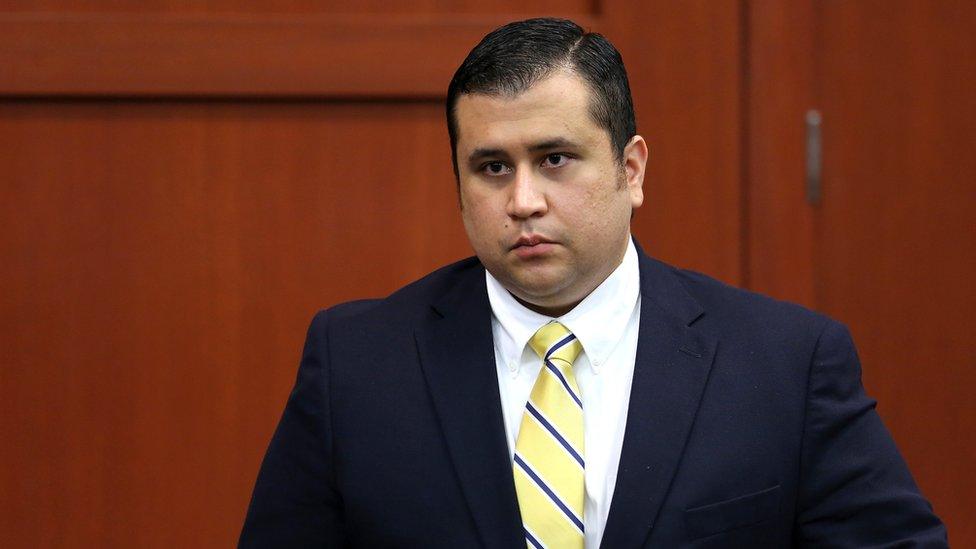How will US museums remember Trayvon Martin?
- Published

George Zimmerman's gun is displayed at his trial
The Smithsonian Institution has denied a claim that it expressed an interest in acquiring the gun that killed black teenager Trayvon Martin. But does such a weapon have a place in a museum?
George Zimmerman made news on Wednesday once again with his attempt to auction off the gun he used to shoot and kill unarmed black teenager Trayvon Martin in 2012.
Mr Zimmerman was acquitted of Trayvon's death for acting in self-defence.
"Many have expressed interest in owning and displaying the firearm including the Smithsonian museum in Washington," Mr Zimmerman wrote in a description of the gun. "This is a piece of American history."
The Smithsonian Institution denied Mr Zimmerman's claim.
"We have never expressed interest in collecting George Zimmerman's firearm," the museum said in a statement. "The Smithsonian has no plans to ever collect or display this object in any of its museums."
However, not everyone scoffed at the idea that the gun should some day find a place in a museum.

George Zimmerman during the trial
There is little debate that Trayvon's death will be marked as a significant historical event, one that touched off the Black Lives Matter movement nationally and continued to echo in the deaths of other unarmed black men, women and children, like Tamir Rice and Michael Brown.
But when it comes to selecting the artefacts that tell those stories, museum curators may have a complex task ahead of them - albeit one they have faced many times before.
"Museums have had a long history of collecting things that have that violent provenance," says Dan Spock, director of the Minnesota History Center Museum.
He points out that the Deringer that killed Abraham Lincoln, external and a replica of the rifle that killed John F Kennedy are currently on display in museums. The Enola Gay, external, the plane that dropped the atomic bomb on Hiroshima, is housed at the National Air and Space Museum.
But American museums also have a long track record of presenting history from a certain, skewed perspective, says Nina Simon, executive director of the Santa Cruz Museum of Art & History and author of the blog Museum 2.0, external. Collection decisions have often favoured people with power.
"Unsurprisingly, museums historically have mostly collected the cultural history of the quote, unquote winners - wealthier people. Whiter people," she says. "How do we more equitably represent those stories than we have in the past?"
That all comes to bear on decisions on what to include in a theoretical collection that will explain the Black Lives Matter movement for decades to come.
"Is it more apt to collect Trayvon Martin's hoodie or collect the weapon with which he was slain?" Mr Spock asks.
"It's a choice. Do you want to collect the object that symbolises the violence... or do you collect the garment that this poor kid was wearing, that not only represents how dangerous it is to be a young black man wearing a hoodie in America, it also became a symbol of how dangerous it is to be black man in America?"

Trayvon Martin's hooded sweatshirt shown at trial
In fact, Lonnie Bunch, director of the Smithsonian's National Museum of African American History and Culture, has mentioned many times, external that he would like to include Trayvon's hooded sweatshirt in an exhibit.
He told NPR the museum has already acquired protest signs, external from Ferguson, Missouri. There was also talk that a museum may acquire the gazebo where 12-year-old Tamir Rice was shot by a Cleveland police officer in 2014.
Not long after Bunch's comments, it became clear that Trayvon's parents were not aware that the Smithsonian might want their son's shirt, and a spokesperson for the Smithsonian released statements saying the museum had not made any attempt to obtain it.
Tamir Rice's family has said they would be open to the gazebo's display if it were done "in an appropriate and dignified manner," according to the family's lawyer.
Sarah Pharaon, senior director of methodology and practice at the International Coalition of Sites of Conscience, says that when museums take objects from controversial incidents, an accounting of the feelings of parties like the victims' families is essential.
"There is a question of readiness," she says. "Healing and grief happens at different paces and speeds for individuals, and it also happens at different paces and speeds for society. I think it is vital that those be decisions that are led, if not entirely led, by the readiness of a community to have these evocative and potentially traumatising objects on display."
Clearly, the Martin family was not consulted about Mr Zimmerman's decision to make the gun available to the public. The family's lawyer, external called the sale "insulting and disrespectful".
To Ms Simon, she thinks if it came down to the choice between displaying the hoodie or displaying the gun, hers would be obvious.
"The hoodie tells a story, not just of a human being whose life was taken away, but it tells the story of how we interpret each other," she says.
"That's a much more complex and powerful story than the story that the gun that extinguished that life tells."
Subscribe to the BBC News Magazine's email newsletter to get articles sent to your inbox.